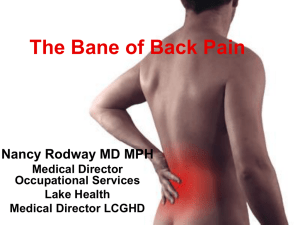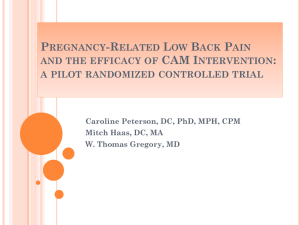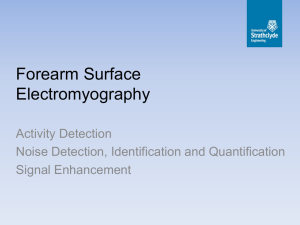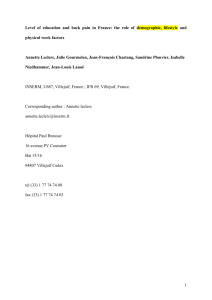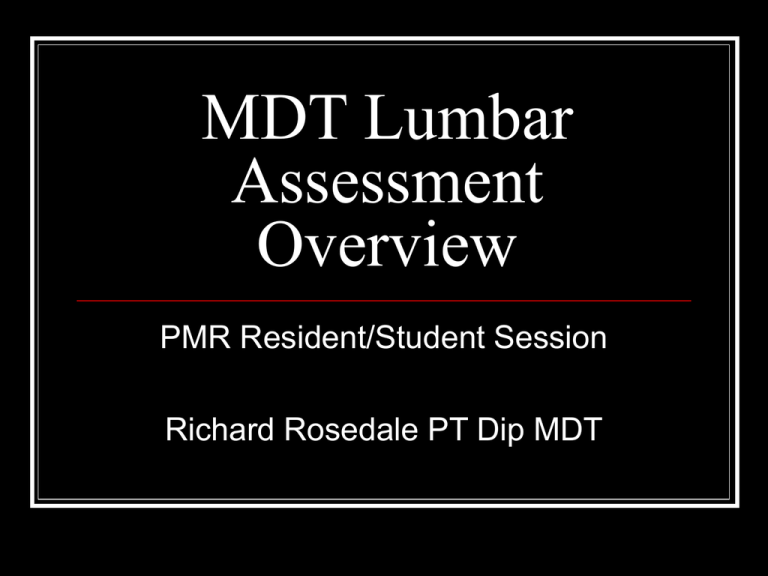
MDT Lumbar
Assessment
Overview
PMR Resident/Student Session
Richard Rosedale PT Dip MDT
A
D
T
O
Lumbar Spine
“T”
How
do you treat?
“D” How do you classify?
Patho-anatomical
“Facet”
Derangement
What’s your Rx? What’s your Rx?
Facet
A
?
D
?
T
Refs…
Laslett 2006
Laslett 2004
Dreyfuss 2003
Young 2003
Revel 1998
Dreyer 1996
Schwarzer 1994
Jackson 1988 etc
Big picture look at “evidence”.
What is the best treatment for chest pain?
What is the best study design to answer
this question?
O
T
D
A
Cardiac
Esoph’l
Chest Pain
Pain
Pain
NTG
Anti-acids
Black Box
RCT
Nothing
Outcome Measures
10% Improved 25%
80% Improved 20%
80%
25%
10%
10% Improved
Are the small benefits worth the additional costs?
“Symptoms” are
poor candidate for RCTs
Chest pain
Abdominal pain
Low back pain
Leg pain “sciatica”
Black
Box
Model
Non-Specific
LBP
Our recent research reality….
Black Box
Model
Non-Specific
LBP
Outcomes
Black Box
RCTs
Treatment
Non-specific results
No intervention is any
better than “doing nothing”.
Spratt (02):
Likewise our guidelines!!
•
RCTs of non-specific LBP “are doomed”.
•
By persisting with studies of non-specific LBP,
“the results of RCTs will continue to be
frustrating, meaningless, and even misleading.”
Bouter, van Tulder, Koes (Spine 98):
•
“There is urgent need for good ideas about how
to identify homogeneous subgroups.”
•
“The efficacy of interventions in the subgroups
should be studied in RCTs.”
Understanding the science
behind the “evidence”.
25 years & approx 1,000 RCTs (black box)
Systematic reviews – (dozens)
International “evidence” based-guidelines
What do we have?
Not much.
Screen for red flags
Advice to remain active
Reassurance
Review psychosocial yellow flags
Generic – “one size fits all” guidelines
Is this the best we can do?
The best treatment
for LBP?
We have been asking the wrong questions!
Testing questions in the wrong order!
“Statistical Relevance”
K. Spratt, Ph.D.
Outcomes
The ADTO Model
“The single most
important thing:
establishing the validity
of any one link requires
that all previous links
have been established.”
Treatment
Diagnosis
Assessment
Book: Orthopaedic Knowledge Update
Spine ‘02, AAOS, p497-505
Start by building the FOUNDATION:
RCTs of subgroups
Prospective subgroup studies:
outcome prediction, with or w/o
treatment(s).
Reliability studies:
• test findings/results
• subgroup classification
Outcomes
Treatment
Diagnosis
Assessment
How does MDT measure up?
Outcomes
Treatment
Diagnosis
Assessment
Reliability studies MDT
Dionne ’06
Laslett 05, 03
Clare 05, 04, 03
Petersen 04, 03
Kilpikoski 02
Werneke 04, 03, 01
Ramzjou 00
Fritz 00, 06
Wilson 99
Donahue 96
Bruijne 03
Riddle 94
Spratt 93
Kilby 90
May 06 systematic review
14+ pain response studies
Diagnosis
Assessment
Prospective subgroup studies:
(observational, case series, prognostic)
George 05, Skytte 05,
Werneke 05, 01, 99
Sufka 98, Donelson 97, 90
Karas 97, Kopp 86
Long 95,
Erhard 94, Alexander 92
Aina 04 review
10+ centralization studies
Treatment
Diagnosis
RCT’s with subgroups:MDT
Brennan 06
Delitto 93,
Fritz 03,
Larsen 02,
Long 04,
Schenk 03,
Williams 91,
Clare 04,
(Rasmussen 05)
Cook 05 Reviews
7 studies
Outcomes
Treatment
An example of how classification
effects outcome
Long et al 2004
312 LBP patients – MDT assessment
230 (74%) had directional preference (DP)
Randomised to:
1. Matched exercise
2. Opposite exercise
3. Evidence-based – active / fear reduction
Study Design
Mechanical Assessment
Directional
Preference
Extension
Randomization
Directional Preference
Excluded
No Directional Preference
Flexion
Lateral
Randomization
Randomization
Matched Directional Opposite
Treatments
EBG
Outcomes 2 weeks – self-rated improvement
(Long et al 2004)
95%
100%
80%
Worse
No Change
60%
42%
40%
23%
20%
Better
Resolved
p<.001
0%
Matched
Opposite
Control
Results:
Interference With Activity
Beck Depression Inventory
4
9.5
3.8
9
3.6
8.5
3.4
8
3.2
7.5
3
7
2.8
6.5
2.6
6
2.4
5.5
2.2
5
2
4.5
1
2
Matched
EBG
p < .001
1
Opposite
Matched
2
EBG
p < .009
Opposite
Results:
•Pills per Day for LBP
Roland-Morris DQ
•56% taking meds
4
19
3.5
18
3
17
2.5
16
2
15
1.5
14
1
13
0.5
12
0
11
1
2
Matched
EBG
P = .016
Opposite
1
Matched
2
EBG
P =.009
Opposite
Results:
Back Pain Intensity
6.5
Leg Pain Intensity
5
6
4.5
5.5
4
5
3.5
4.5
4
3
3.5
2.5
3
2
2.5
1.5
2
1
2
Matched
EBG
P < .001
Opposite
1
1
2
Matched
EBG
P =.003
Opposite
If classification was the key…what
would you need?
Reliable
assessment
System to classify
Valid classifications
What about treatment?
Natural history of LBP
Persistence is common - symptoms for
several months
Linton et al 1998
Hillman et al 1996
Waxman et al 2000
Szpalski et al 1995
43%
47%
42%
36%
Natural history of LBP
Relapse is common
- more than one episode in a year
Linton et al 1998
Brown et al 1998
Heliovaara et al 1989
Toroptsova et al 1995
Klenerman et al 1995
57%
55%
45%
65%
72%
What are the treatment implications of
the epidemiological evidence?
Self Treatment
How do we know
the patient can
treat themselves?
Assessment based
around patient
generated forces
Patient generated forces assessment
How do you do that?
Assessment Practical
How many LBP patients can be
assessed and treated using self
generated forces?
Hefford 2008
Cervical
81% Derangements
Thoracic
87% Derangements
Lumbar
75% Derangements
Directional Preference
Mechanical loading
examination
including RMs
Identification of specific
directional exercise
Confirms classification
of Derangement
Symptoms centralize
or decrease or
range increases
MDT
Assessment of the effect of loading
and movement on symptoms
Directional Preference
Centralization
Derangement
Dysfunction
Specific Directional Exercise
Posture
Other
Alternate loading Strategy
Contrast with other treatment
approaches
Repeated movements for assessment
and management
Emphasis on patient independence
Avoidance of therapist dependency
Use of minimal intervention
Exercise and therapist intervention
Exercises used for pain relief
THE MCKENZIE INSTITUTE
LUMBAR SPINE ASSESSMENT
Date
Name
Sex M / F
Address
Telephone
Date of Birth
Age
Referral: GP / Orth / Self / Other
Work: Mechanical Stresses
Leisure: Mechanical Stresses
Functional Disability from present episode
Functional Disability score
VAS Score (0-10)
HISTORY
Present Symptoms
Present since
Improving / Unchanging / Worsening
Functional Disability score
VAS Score (0-10)
HISTORY
Present Symptoms
Present since
Improving / Unchanging / Worsening
Commenced as a result of
Or no apparent reason
Symptoms at onset: back / thigh / leg
Intermittent symptoms: back / thigh / leg
Constant symptoms: back / thigh / leg
Worse
bending
Sitting / rising
standing
am / as the day progresses / pm
walking
lying
when still / on the move
other
Better
bending
sitting
am / as the day progresses / pm
standing
walking
lying
when still / on the move
other
Disturbed Sleep
Yes / No
Sleeping postures: prone / sup / side R / L
Surface: firm / soft / sag
am / as the day progresses / pm
when still / on the move
other
Disturbed Sleep
Yes / No
Previous Episodes 0
1-5
Sleeping postures: prone / sup / side R / L
6-10
11+
Surface: firm / soft / sag
Year of first episode
Previous History
Previous Treatments
SPECIFIC QUESTIONS
Cough / Sneeze / Strain / +ve / -ve
Bladder: normal / abnormal
Gait: normal / abnormal
Medications: Nil / NSAIDS / Analg / Steroids / Anticoag / Other
General Health: Good / Fair / Poor
Imaging: Yes / No
Recent or major surgery: Yes / No
Night Pain: Yes / No
Accidents: Yes / No
Unexplained weight loss: Yes / No
Other:
McKenzie Institute International 2005©
Red flag clues
Age > 55
History of cancer
Unexplained weight loss
Constant, progressive, non-mechanical
pain, worse at rest
Systemically unwell
Persisting severe restriction of lumbar
flexion
Red flag clues
Systemic steroids
History of IV drug use
History of significant trauma
History of trivial trauma and severe pain in
osteoporotic individual
No movement or position centralises,
decreases, or abolishes pain
Cancer
“ A previous history of cancer has such
high specificity (0.98) that such patients
should be considered to have cancer
until proven otherwise”
Deyo 1992
If Age > 50
OR History of cancer
OR Unexplained weight loss
OR Failure to improve with conservative
therapy
THEN…
sensitivity = 1.00
Aims of the Physical
Examination
Usual posture
Symptomatic response to posture
correction
Any obvious deformities or asymmetries
Baseline measures of mechanical
presentation
Neurological examination
Symptomatic and mechanical response to
repeated movements
Conclusion
Syndrome classification
Appropriate therapeutic loading strategy
Appropriate testing loading strategy
Physical Examination
Sitting posture and its effect of pain
Posture correction
Better
Worse
No Effect
Standing posture
Physical Exam
Lordosis
Lateral shift
Movement loss:
What are we looking for here?
Range of movement
Pain or stiffness that stops the movement
Movement pathway deviation
Confidence and willingness to move
Curve reversal
Repeated movements
Flexion in standing
Extension in standing
Flexion in lying
Extension in lying
Side gliding (as required)
BASELINES
Symptomatic
Mechanical
Other Tests
SIJ
Hip
Be aware of false positives
Provisional Classification
Derangement
Dysfunction
Posture
Other……
Summary
What is MDT? (McKenzie Method® )
Diagnostic – Reliability
Prognostic – Validity
Therapeutic – Dx/Rx link
Client centered – Patient empowerment
Prophylactic – Prevent recurrences


